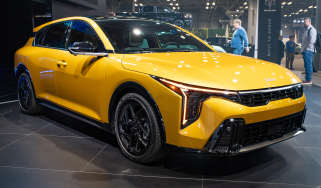DS 3 - Interior, design and technology
It’s boldly designed but the DS 3 doesn’t quite have the substance to back up its style

The original DS 3 Crossback was the first PSA Group product to use the Common Modular Platform (CMP). This platform has now been carried over by the brand’s new parent company, Stellantis, and it's the same one that’s found under the Peugeot 2008 and Vauxhall Mokka. It’s a rigid structure that’s also been designed to allow for the inclusion of electrified powertrains, uprated in-car technology and Level 2 autonomous driving aids.
From the outside, the DS 3 looks the part. Thanks to a bold front end with a large grille, a usefully lofty ride height, and a distinctive kick in the windowline on the car’s profile, it won't be mistaken for anything else. The party-piece deployable door handles pop out when you unlock the car, while the DS 3 stands out thanks to its pair of vertical LED strakes on either side of the grille.
There are up to seven exterior colour choices, and depending upon your trim choice, the grille is either decorated with gloss black or chromed diamond tips, a contrasting roof, and four different alloy wheel designs.
Things are just as interesting inside. The interior is a cacophony of tactile materials, geometric shapes and (unfortunately) oddly placed buttons. It looks unlike anything else on the market, but clearly, the design has been put ahead of ergonomics in some places. Lots of key features are controlled via the car’s dash-top infotainment screen, and instead of any physical buttons, the DS 3 uses touch-sensitive diamond-shaped tiles that offer no haptic feedback to let you know you’ve pressed them hard enough. This isn’t helpful on the move, especially considering we had to press some buttons multiple times before anything happened at all.
Of the few physical controls there are, the electric door mirror controls are hidden behind the steering wheel and are difficult to see. Meanwhile, all the window switches are located around the gear lever, and they have a geometric pattern that may look nice, but it is impossible to differentiate between them at a glance. It all takes a bit of getting used to the DS 3’s strange layout.
However, the premium material choices don’t suffer significantly in lower-spec models compared with higher trim levels. In our view, the entry-level Performance Line model is classy enough inside to make you question the worth of opting for the high-end Esprit de Voyage and Opera cars.
If you’re heart is set on going for one of the pricier models, then Esprit de Voyage swaps the Alcantara of Performance Line in favour of Pebble Grey cloth seat trim with diamond-shaped Nappa leather highlights. Opera boasts full-leather seat trim of Art Basalt Black Nappa leather, along with heated and massaging front seats, wireless phone charging, and a head-up display. You also get a 360-degree camera system, and the Safety Pack. The Safety Pack might be worthwhile for some buyers, but it isn’t essential when the DS 3 isn’t that big and has rear parking sensors standard across the range.
Sat-nav, stereo and infotainment
All DS 3s use a 10.3-inch touchscreen with Apple CarPlay and Android Auto smartphone connectivity. Esprit de Voyage and Opera trims get the upgraded Iris infotainment system, which includes 3D navigation and voice recognition.
There are plenty of features, and the updated infotainment system is easier to use than the one found in older DS 3 Crossback models. The main screen is much more responsive, and the smartphone-style menus work rather well. However, navigating through menus to use the climate control system can quickly become frustrating.










